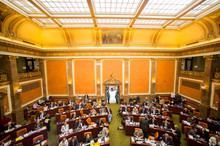This is an archived article that was published on sltrib.com in 2014, and information in the article may be outdated. It is provided only for personal research purposes and may not be reprinted.
Utah lawmakers can breathe a little easier, after getting updated budget numbers Friday that show they will have an extra $58 million to cover hot spots and funding requests in the state budget.
Senate budget chairman Lyle Hillyard, R-Logan, said the figures were much better than expected, but cautioned his colleagues not to get too excited.
"We're having a devil of a time funding the requests already made," he said.
Hillyard said budget subcommittees recommended $800 million in new spending for the 2015 budget year — far exceeding what legislators had available to spend. The new revenue projections mean legislators will have a total of $253 million to spend on new, ongoing programs.
They also have $144 million that can be spent on one-time purchases, things like buildings, roads and vehicles that won't need continuing funding each year.
In total, the revised projections change the overall state budget of roughly $13.5 billion by less than 1 percent.
"The new revenue doesn't mean we've got new money to spend elsewhere," Hillyard said.
Figures show the state's economy is growing faster than economists predicted in October, especially Utah's job market, yielding strong growth in income tax collections. Under Utah's Constitution, all income taxes paid in the state are earmarked for public and higher education.
Utah's sales tax collections came in below already tepid projections.
With the release of new budget figures, lawmakers begin in earnest the task of building the state budget for coming years. There is broad agreement on top priorities.
Legislative leaders in both the House and Senate, as well as Gov. Gary Herbert, have said education is atop the list.
They want to spend more than $60 million to pay for an additional 10,000 new students who are expected to enroll in Utah schools in the coming year, and to increase the state's lowest-in-the-nation, per-pupil spending by 2.5 percent. That would cost about $61 million.
Hillyard has said one of his priorities is to give state workers a raise comparable to what teachers would receive, which would cost about $30 million.
Herbert also has said he is focused on equalizing funding to the state's colleges and universities, a projected cost of about $30 million.
House Speaker Becky Lockhart, R-Provo, and Rep. Francis Gibson, R-Mapleton, also are proposing an aggressive education technology initiative, aimed at moving the state toward a goal of giving each of its more than 600,000 students a digital learning device. Lockhart is seeking $200 million for the project, but both Herbert and leaders in the Senate say it is unlikely that much will be available.
Under a health care plan coming out of the House, legislators also have to find about $35 million to provide health coverage to the state's poorest Utahns — those making about $11,000 a year — who are not eligible for Medicaid.
Numerous agencies and projects want more money.
The state prison system is looking to lease additional cell space in county jails to keep pace with growing inmate populations; a fund used to provide health care and other services to crime victims is on the verge of running out of money and needs an infusion; millions of dollars are needed to cover Utahns added to the Medicaid program under Obamacare; and several million dollars have been requested for various air-quality projects and research as well.
Legislative leaders hope to complete most budget deliberations by next Friday. The 2014 session ends March 13.
Twitter: @RobertGehrke



